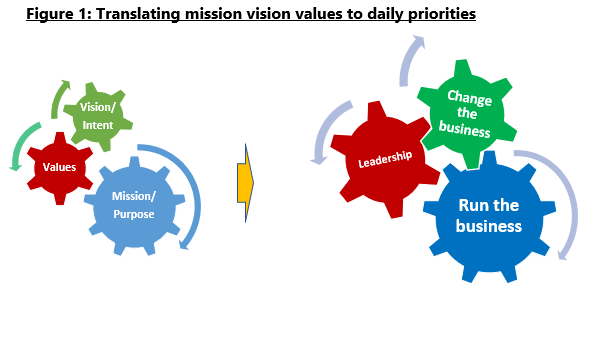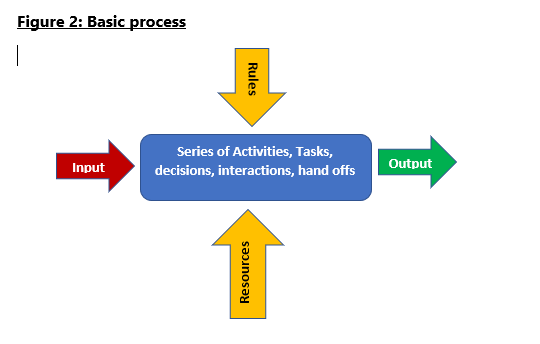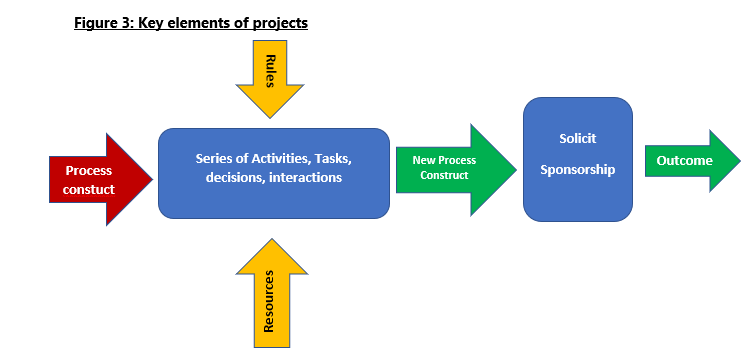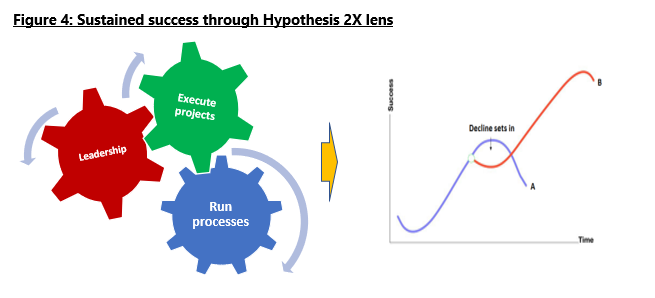The Orgtology Blog
RUN THE BUSINESS AND CHANGE THE BUSINESS FOR SUSTAINED SUCCESS, AN ORGTOLOGY LENS
1. Abstract
Sustained success is achieved if leadership establish the delicate balance between seeking optimum efficiency from running operations through business processes and executing projects to change the business at the right time to adapt to external factors. This is to ensure the organization remains a relevant member of its ecosystem. Strong leadership creates the conducive dynamics for healthy internal and external stakeholder relationships necessary for sustained success.
2. Background
Sustained success is an ambition for every organization, and strategic plans are developed to achieve this ambition. While the strategic plans articulate the mission, vision and values, not all organizations translate this to day to day activities. Consequently, they fail to achieve their ambition for sustained success.
For most organizations mission, vision and values are slogans that employees are aware of yet lack the knowledge and ability to influence their day to day activities. These statements are meant articulate the organization's identity.
Most organizations focus their attention to operational activities with the aim to satisfy the current needs of key stakeholders in order to achieve immediate term targets. For most companies these are growth and efficiency targets. The focus on operational activities over time enables the organization to reach optimal efficiency in realizing their mission. Is achieving optimal efficiency in delivering on your mission enough for sustained success?
Those who have aligned their day-to-day activities to all three dimensions, that is their mission, vision and values. have transformed their organizations into efficient and relevant organizations. These organizations are on an upward growth trajectory, achieving continuous success. What is the secret of their success? This paper demystifies the mission, vision and values using the Hypothesis 2x from the Orgtology Institute.
3. Hypothesis 2X
Through the orgtology Hypothesis 2X (Hendrikz, 2020) we learn about the duality in organizations and the X-Factor. The duality starts with articulating the mission and vision, the expression of a statement of purpose and intent. The purpose directs processes that drive day to day operational activities and deliver known products and services in accordance with the mandate of the organization or its value proposition. This is the receptive part of the activities of the organization. It seeks to achieve stability by following known procedures. The ultimate desire is delivering on the needs efficiently.
Intent aims to keep the value proposition of the organization aligned with its changing environment. Intent drives the desire to transform operational activities to a future state that produce service/products that continue excite stakeholders. This change disrupts current processes. The disruption is necessary as the organization wants to be sponsored by key stakeholders in perpetuity, in other words the organization's desire is to continuously change in order to be be a going concern.
The values articulate the desired behaviour of the organization. The soul of the organization. They articulate a commitment to build strong and meaningful relationships with key stakeholders, be it internal or external. This is the most unpredictable part of the organization's ambitions, and it is powered by the X-Factor. Strong internal relationships lead to a conducive working environment. With key external stakeholders, strong relationships help the organization understand their unpredictable changing needs, and keep the organization effectively aligned to ensure sponsorship or support by the key stakeholders.
Running the business processes to deliver known products is driven by receptive forces. The desire to change the processes to deliver improved products that aligns to shifting stakeholder demands is driven by projective forces. The receptive and projective forces should exist at the same time in order to deliver on current and future needs. The paradox here is that the two opposing forces draw from the same resource pool. The organization has a finite budget that must be allocated to receptive and projective activities. If inadequate resources are allocated to deliver today's products efficiently, then the inefficiency will eventually lead to downfall. If inadequate resources are allocated to fuel change in processes in preparation for products/service delivery in future, then the organization will do well today but become irrelevant over time. The remedy is to strike the balance between efficiency today and relevance in future by running the business while changing the business (AXELOS Limited Global Best Practice , 2013).
4. Effective leadership will create an effective dynamics climate
The statement of Purpose is supported by the business processes. The end game is to produce outputs with minimal use of resources, achieving efficiency. Doing the same thing over and over again allows the organization to climb the learning curve, achieving significant efficiency over time. The statement of intent drives visualization of the future state of operations. It is powered by projects that seek to change the business processes in readiness for the future. The end game is the improvement of processes to position them to produce products that appeals to stakeholders well into the future. Leadership is the oil that keeps the machinery running. Leadership keeps the organization in touch with its external environment. Internally leadership maintains healthy human dynamics climate, that keeps employees effectively engaged as well as ready to change their attitudes and behaviour to align to the ever-changing needs of the external environment.
5. Receptive forces run the business processes for efficiencies
A business process is a group of activities that are designed to take inputs and transform it to a product or service to satisfy a customer need. The activities are guided by rules and they consume resources.
The resources could be a combination of machine hours, labour hours and material. The efficiency is achieved if for the same or better level of quality of one unit of output is produced while consuming less resources (labour hours, material, machine hours). The substitution of expensive resources for cheaper resources will result in efficiencies as well.
With industrialization we witnessed the reduction in the use of labour hours and increase in machine hours in the production lines. With the 4rd industrial revolution, more labour hours are substituted by machine hours provided by machines equipped with cognitive skills. The major advantage here is the reduction in variability that comes with human dynamics, the source of labour hours. Also, machines can continue to work 24x7. The disadvantage is the loss of the X-Factor that humans bring in processes. The X-Factor is discussed below.
Where processes require significant labour hours, strong leadership plays a role in the reducing variability. Leadership motivates staff, the source of labour hours, to supply their effort in accordance with the requirements of the process. The adoption of performance management systems is another technique to influence the supply of labour hours. The process targets are aligned with performance targets to influence the reduction in the variability that comes with the X-Factor. Performance management system are primarily meant to influence internal staff to effectively fuel the process with labour hours on time and to the required standards.
6. Projective forces transform the business Projective forces are driven by intent
Projective forces deliver a future state of operations that delivers products / services that are sponsored by key stakeholders. The future state can be achieved by small incremental changes to the processes or major transformation within a short period of time. Projects are the most effective vehicle for achieving the transformation of operations within a relatively short period of time. The rapid change in stakeholders' needs has resulted in the wide adoption of projects as a means to infuse cycles of rapid change on organizations.
What is the difference between a process and a strategic project? Both consume inputs to produce outputs. Both are a series of activities and tasks that consume resources to produce results. However, strategic projects deliver outcomes, while processes deliver known outputs. Further, the objective of implementing projects is to improve processes. Therefore a project is a process that transforms operations to deliver business improvements. Projects are implemented by temporary organizational structures while processes are implemented by permanent structures.
Now we can summarise the role of projects and processes by their goals. The process construct delivers know products repeatedly, climbing the learning curve to master the operational cycle resulting in efficiencies. The project construct transforms the process construct to produce products that are sponsored by key stakeholders resulting in business improvements. Success in projects require strong leadership as projects introduce change in day-to-day activities. The role of the leadership is to persuade stakeholders to sponsor the products of the new process construct. Stakeholders are unpredictable. There is always the risk that the response of stakeholders to the new products will not be positive. This is what sets companies apart, the ability to solicit sponsorship for products of the process construct.
7. The X-Factor
The X-Factory is the unpredictable ingredient in the project and process construct. As outlined above, where a process consumes labour hours, there is an element of unpredictability there. Performance management will seek to reduce the unpredictability. The unpredictability is not automatically bad. As employees works on the process and they may be tempted to deviated from the rules and alter it to test the impact of the alteration. We look at the story behind the Coca Cola recipe as a good outcome of the X-Factor. John Stith Pemberton (July 8, 1831 – August 16, 1888) (Wikipedia, 2021) was an American biochemist, and soldier who decide to experiment with various pain killers to treat himself. So he altered the process of making painkillers and ended up with a recipe for the nice tasting product, the Coca Cola beverage. In short, the X-Factor brings mutations in the processes, and some of the mutations are good for the company yet some are not. The X-Factor brings innovation that disturb or change processes for better or worse.
Leadership is central to the management of the X-Factor to ensure the organization benefits from the unpredictability in human dynamics. Strong leadership leads to organizations adapting to the organizational values, resulting in a culture that is conducive to the running of processes and execution of projects. Leadership is central to the sponsorship of the organization and its products by the outside environment. According to (Striekland, Arthur Thompson & J, 1996), a strong culture and a tight strategy-culture fit are powerful levers for influencing people to do their jobs better. A company strategy-culture bond can be weak and fragmented in the sense that many subcultures may exist, few values and behavioural norms are shared, and there are few traditions.
According to Striekland, cultivating the needed culture-building values and behaviour depends on a sincere, sustained commitment by the leadership coupled with extraordinary persistence in reinforcing the desired culture at every opportunity through both word and deed. He goes on to say very often the elements of company culture originate with early influential leaders who articulate certain values, beliefs and principles that get incorporated into strategies and operating practices. This means the behaviour of an organization is a reflection of the leadership of that organization.
8. Summary and Conclusion
Mission or purpose is driven by the value proposition of the organization or the mandate from the shareholder. Business processes are the vehicle for fulfilling the mandate or honouring the promise made in the value proposition. Until the value proposition changes, or the mandate changes, the processes deliver the same products, while reducing inputs in order to achieve efficiencies. Business process management will help the organization run the business operations and achieve efficiencies.
The vision or intent represent ambition to see the processes transformed to a future state that will ensure the organization remains sponsored or supported by key stakeholders. The vision is powered by strategic projects implemented by temporary structure, project teams. The resources to run these temporary structures are drawn from the resources that run operations. This is where the paradox arises, the duality. Redirecting resources to projects starves operations, yet ignoring the execution of projects to introduce change also leads to operations producing irrelevance products in future. So, the delicate balance between "running the business and changing the business" needs to be established and maintained.
The common denominator of all organizations is the existence of stakeholders. Within the organization the stakeholders are employees who drive the processes and execute the projects. The impact of their unpredictability is heavily influenced by the leadership of the organization. Their behaviour in the organization reflects the action and language of the leadership of the organization. This therefore means the ability of an organization to live the company values is influenced by the leaders. The ability of an organization to innovate and stay ahead of competitors and continuously exceed the expectation of customers is influenced by leadership.
We conclude therefore that sustained success comes from strong leadership that inspire running the business and changing the business for short term efficiencies and relevance in the long term
Hypothesis 2X therefore leads to sustained success as shown in the figure above. Business processes shall facilitate realisation of Purpose and get the company into curve A, and small incremental process improvements will see the company climb the curve. The X-Factor drives the small incremental process improvements. While all is good and the company is enjoying success, Intent will drive development of strategy that outlines projects to change processes to transform the operations and jump into curve B. Jumping into Curve B lands internal and external stakeholders into a new environment, disturbing comfort zones, requiring change in behaviour. It will negatively affect the productivity in the early stages while trying to adapt. However, with strong leadership, the organization gradually bounces back and is in an upward trajectory. The processes (stability) and projects (instability) are funded from the same resource pool and have an inverse relationship with each other yet necessary. The leaders must ensure an effective balance in the allocation of resources to fund running the business and changing the business.
Bibliography
Hendrikz, D. (2020, April 24). Hyphothesis 2X the Foundation of Orgtology. From Orgtology Institute: https://orgtology.org/index.php/2015-06-01-09-45-25/orgtology-blog/69-hypothesis-2x-of-orgtology
Striekland, Arthur Thompson & J. (1996). Strategic Management - Concepts and Cases. Mexico City: IRWIN.
AXELOS Limited Global Best Practice (2013)Portfolio, Programme and Project Offices (P30®) 2nd edition, The Stationer Office
Wikipedia. (2021, March 05). John_Stith_Pemberton. From Wikipedia: https://en.wikipedia.org/wiki/John_Stith_Pemberton
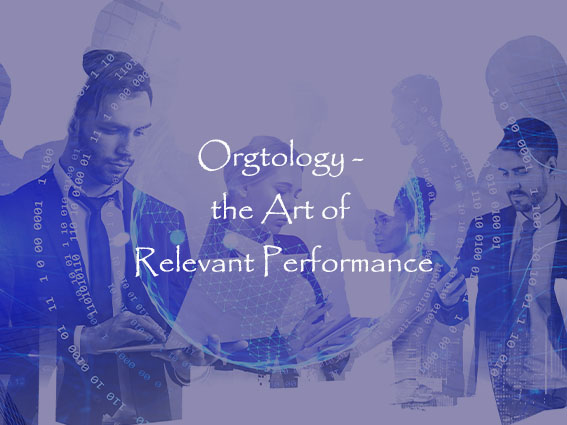
Join the Orgtologist Certification Program (OCP) and become a Certified Orgtologist with the International Orgtology Institute
The program is highly suitable for senior managers, directors, executives, and those who aim for senior positions within an organisation. The OCP has four parts. They are: orgtology theory, organisational design, strategy, management and leadership. This is an advanced program. To enroll, you must hold a bachelor's degree with three years of work experience. On completion, you can enroll as an Orgtologist with the International Orgtology Institute (IOI).
Copyright
© 31 March 2021
When you subscribe to the blog, we will send you an e-mail when there are new updates on the site so you wouldn't miss them.


